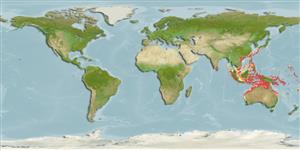Common names from other countries
>
Eupercaria/misc (Various families in series Eupercaria) >
Labridae (Wrasses) > Bodianinae
Etymology: Choerodon: Greek, choiros = a pig + odous = teeth (Ref. 45335); referrring to the prominent anterior canines of the species in this genus (Ref. 116605); zamboangae: Named for its type locality, Zamboanga, southern Philippines..
More on authors: Seale & Bean.
Environment: milieu / climate zone / depth range / distribution range
Ecología
marino asociado a arrecife; rango de profundidad 25 - 60 m (Ref. 90102). Tropical
Distribución
Países | Áreas FAO | Ecosistemas | Ocurrencias, apariciones | Point map | Introducciones | Faunafri
Indo-West Pacific: Philippines (Ref. 9710) to Indonesia and northwestern Australia. Possibly the male of Choerodon robustus (Ref. 9710).
Tamaño / Peso / Age
Maturity: Lm ? range ? - ? cm
Max length : 45.0 cm TL macho / no sexado; (Ref. 48636)
Espinas dorsales (total) : 13; Radios blandos dorsales (total) : 7; Espinas anales: 3; Radios blandos anales: 10. Body without a broad dark, pale-margined, oblique band on side; body bicoloured, dusky anterodorsally and pale posteroventrally, line of demarcation extending between base of first dorsal-fin spine and upper side of pectoral-fin base; a broad anteroventrally tapering reddish brown stripe covering dorsal half of side posterior to greenish brown anterodorsal portion of body; reddish brown area edged ventrally by yellow stripe. (Ref 9823)
Found on deep outer reef habitats; flat sandy or weedy areas. Rarely seen by diving and is usually caught on lines from deep water (Ref. 48636). Usually found solitary, in rubble bottoms near seaward reefs. C. melanostigma is a junior synonym (Ref. 90102).
Life cycle and mating behavior
Maturities | Reproducción | Spawnings | Egg(s) | Fecundities | Larva
Oviparous, distinct pairing during breeding (Ref. 205).
Sainsbury, K.J., P.J. Kailola and G.G. Leyland, 1985. Continental shelf fishes of the northern and north-western Australia. An illustrated guide. CSIRO Division of Fisheries Research; Clouston & Hall and Peter Pownall Fisheries Information Service, Canberra, Australia. 375 p. (Ref. 3131)
IUCN Red List Status (Ref. 130435)
CITES (Ref. 128078)
Not Evaluated
Threat to humans
Harmless
Human uses
Herramientas
Special reports
Download XML
Fuentes de Internet
Estimates based on models
Preferred temperature (Ref.
115969): 24.2 - 28.4, mean 27.2 (based on 101 cells).
Phylogenetic diversity index (Ref.
82804): PD
50 = 0.5000 [Uniqueness, from 0.5 = low to 2.0 = high].
Bayesian length-weight: a=0.01318 (0.00582 - 0.02984), b=3.05 (2.86 - 3.24), in cm Total Length, based on LWR estimates for this (Sub)family-body shape (Ref.
93245).
Nivel trófico (Ref.
69278): 3.5 ±0.4 se; based on size and trophs of closest relatives
Resiliencia (Ref.
120179): Medio, población duplicada en un tiempo mínimo de 1.4-4.4 años (Preliminary K or Fecundity.).
Fishing Vulnerability (Ref.
59153): Low to moderate vulnerability (35 of 100).
